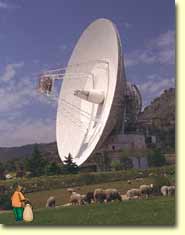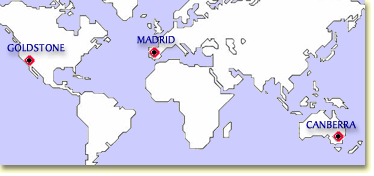

|
What
do you think is . . . Wittier
than a wiley wizard? Awesome as her powers are, however, no superhero can match what ordinary humans have done to solve one really big problem of space exploration. How ever do we communicate with the tiny spacecraft we send out to explore deep, dark space and strange other worlds? The
answer is . . . (drum roll here, please) the   The enormous antennas of the Deep Space Network are so sensitive they can hear what amounts to a tiny whisper from millions, or even billions, of miles away.  This world map shows the three locations of the Deep Space Network's antennas. As Earth rotates on its axis, a spacecraft way out in space will be able to "see" at least one set of antennas. Each of the three locations has several antennas for tracking different spacecraft at the same time. The largest of these dish antennas is 70 meters (about 230 feet) across. The movable part of the antenna weighs 3000 tons (6 million pounds). Even though it is like steering something the size of a soccer field loaded with 50,000 screaming fans, the antenna can be pointed so accurately that it could exactly target a soccer ball two miles away.
It is very hard to imagine how weak that signal is. Suppose you spent the time shown in the first column of the chart below gathering and storing up all the energy the 70-meter antenna collects from this tiny signal. The total energy saved up would light a standard 4-watt Christmas tree bulb for only as long as the time shown in the second column. |
|
Store
the Signal for |
To
Light a Bulb for |
|
|
400 years |
1 100-millionth of a second |
|
|
40,000 years |
1 millionth of a second |
|
|
For as long as it has been since the dinosaurs became extinct |
Less than 2 thousandths of a second |
|
|
For as long as Earth has existed |
1/10 second (this is how long the bulb at the right is staying on) |
|
The size of the antenna goes a long way to make it so sensitive. The electronics, computers, and other advanced technologies complete the job of finding, amplifying (turning up the volume), and decoding the important messages from our interplanetary explorers. |
|
|
|||||

 The
spacecraft transmitter that sends the signal to Earth is
about as powerful as the little light bulb in your
refrigerator. By the time it reaches Earth, the spacecraft
signal delivers only 0.000000000000000003 watts of energy to
the 70-meter antenna. But the antenna can still detect
it!
The
spacecraft transmitter that sends the signal to Earth is
about as powerful as the little light bulb in your
refrigerator. By the time it reaches Earth, the spacecraft
signal delivers only 0.000000000000000003 watts of energy to
the 70-meter antenna. But the antenna can still detect
it!





